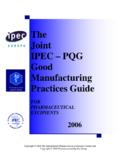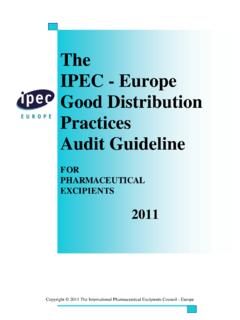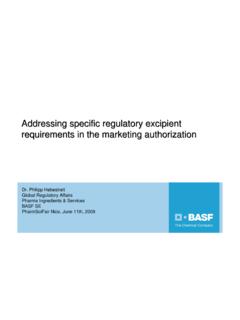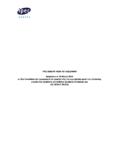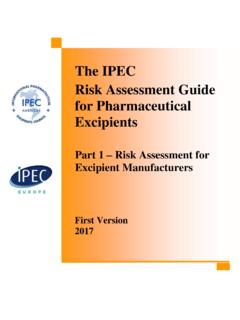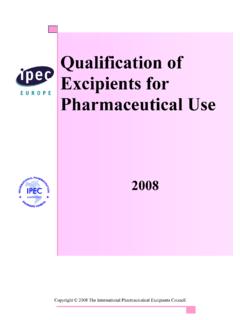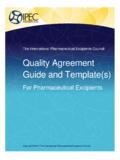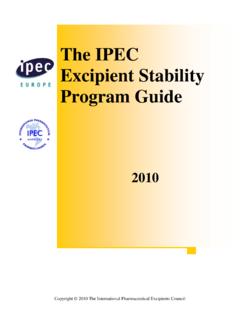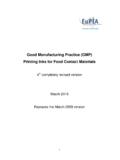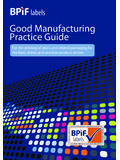Transcription of Excipient Audit Guideline - IPEC Europe
1 The Joint IPEC-PQG. Good Manufacturing Practices Audit Guideline FOR. PHARMACEUTICAL. EXCIPIENTS. 2008. Copyright 2008 The International Pharmaceutical Excipients Council Copyright 2008 Pharmaceutical Quality Group IPEC Good Manufacturing Practices Audit Guideline for Pharmaceutical Excipients I. Purpose and Scope In the pharmaceutical industry it is the responsibility of the drug product manufacturer to ensure the quality of all starting materials and other components contained in or used in the manufacture of the final product dosage form. Through auditing the producer of pharmaceutical excipients, a user is able to determine whether adequate controls are in place to ensure the producer is capable to manufacture a product of suitable quality. The IPEC-PQG Audit Guideline (the Audit Guideline ) is therefore designed as a tool to assist in evaluating the manufacturing practices and quality systems of Excipient manufacturers. It is also a helpful reference to assist Excipient manufacturers in meeting appropriate good manufacturing practice (GMP) requirements to assure consistent product quality.
2 The Audit Guideline is applicable whenever an Excipient manufacturer or subcontractor is audited. It is intended to have international application, bearing in mind that production of pharmaceutical excipients covers a diverse range of different industries and processes which often have uses other than pharmaceutical applications. Although the Audit may include other areas such as delivery logistics and order processing, the Audit Guideline is intended only to cover aspects of GMP relating to Excipient manufacture. For auditing of repackagers or distributors, see the IPEC Good Distribution Practices Audit Guideline for Pharmaceutical Excipients. II. Content and Usage The Joint IPEC-PQG "Good Manufacturing Practices Guide for Pharmaceutical Excipients" 2006 was used as the basis to construct the questions or reminder phrases contained in the Audit Guideline , and should serve as the primary source for evaluating responses provided by the auditee.
3 The auditors should be familiar with the introduction, definitions, and general guidance that are contained within the IPEC-PQG GMP Guide, and should refer to the guide if further details are needed. The Audit Guideline is intended to address the foundation of the requirements, and not all of the details, necessary to manufacture excipients in compliance with applicable GMPs. It may not include all of the appropriate questions or reminder phrases for a specific Audit , nor may all of the points be appropriate to every Audit . As an international document, it also cannot specify all national legal requirements, nor cover in detail the particular characteristics of every Excipient . However, its use is intended for individuals experienced and competent in the area of auditing who should be diligent in selecting which areas of GMP. are relevant to a particular Audit and in determining the appropriateness of questions (and the answers provided) based on the characteristics of the Excipient manufactured, the processes employed, and specific requirements of the Excipient user.
4 III. Format This Audit Guideline is provided in two formats, either of which may be used by the auditor based on personal preference: Detailed questions arranged in the same sequence as in the GMP Guide. This format is useful as a training tool for personnel of both the auditing company and one being audited. Short "reminder" phrases arranged in the same sequence as in the GMP Guide, a format which generally is more useful during an Audit . IV. Acknowledgements Copyright 2008 The International Pharmaceutical Excipients Council Copyright 2008 Pharmaceutical Quality Group Page 2 of 37. This Guide was prepared by a team from The International Pharmaceutical Excipients Council (IPEC) and the Charted Quality Institute (CQI) Pharmaceutical Quality Group (PQG). IPEC. IPEC is an international industry association formed in 1991 by manufacturers and end-users of excipients. It is an association comprising three regional pharmaceutical Excipient industry associations covering the United States, Europe and Japan (which are known respectively as IPEC-Americas, IPEC Europe and JPEC).
5 IPEC's objectives are to contribute to the development and harmonization of international Excipient standards, the introduction of useful new excipients to the marketplace and the development of good manufacturing practice for excipients. IPEC first published its GMP Audit Guide for Bulk Pharmaceutical Excipients in 1995 and it was revised in 2004 to align it with the revised 2001 GMP guide. For further information see PQG. The PQG was formed in 1977 to promote development of a consistent approach to pharmaceutical quality and good manufacturing practice. The group has since expanded and is now incorporated within the United Kingdom's Charted Quality Institute. In 1990 the PQG published three codes of practice to cover pharmaceutical raw materials, printed and contact packaging materials. In 1995 the codes were revised and were integrated into ISO 9002:1994. The code for raw materials was revised and reissued as PS 9100:2002 Pharmaceutical Excipients, an application standard and GMP guide for pharmaceutical excipients.
6 For further information see IPEC and PQG greatly appreciate and acknowledge the many hours of hard work the following individuals devoted to creating this Guideline and the generous support provided by their employers: CORE REVISION TEAM. IPEC-AMERICAS. Dale Carter, Archer Daniels Midland Company Sidney A. Goode, , The Dow Chemical Company David B. Klug, sanofi aventis Pharmaceuticals, Inc. Philip Merrell, , Jost Chemical Company R. Christian Moreton, , Finn Brit Associates David R. Schoneker, Colorcon Inc. Irwin B. Silverstein, , IBS Consulting in Quality (committee consultant). Priscilla Zawislak, Hercules Inc. Copyright 2008 The International Pharmaceutical Excipients Council Copyright 2008 Pharmaceutical Quality Group Page 3 of 37. IPEC Europe . Kevin McGlue, CSci., CChem, MRSC, Colorcon Ltd Gianluca Minestrini, , F. Hoffmann La Roche Iain Moore, , CChem MRSC, MCQI, Croda Chemicals Europe Ltd Patricia Rafidison, RPh, , Dow Corning PQG.
7 Steve Moss Ph. D., MBA, CChem FRSC, MCQI, GlaxoSmithKline Copyright 2008 The International Pharmaceutical Excipients Council Copyright 2008 Pharmaceutical Quality Group Page 4 of 37. The International Pharmaceutical Excipients Council Pharmaceutical Quality Group JOINT GMP Audit Guideline . FOR. PHARMACEUTICAL EXCIPIENTS. 2008. Format: Detailed Questions in Sequence of the IPEC-PQG GMP Guide Copyright 2008 The International Pharmaceutical Excipients Council & Copyright 2008 Pharmaceutical Quality Group Page 5 of 37. JOINT IPEC-PQG GMP Audit Guideline FOR PHARMACEUTICAL EXCIPIENTS. Guideline NOTES. 4 QUALITY MANAGEMENT SYSTEMS - Excipient QUALITY SYSTEMS. General Requirements Documentation Requirements General Quality Manual Is there a Quality Manual and if so, what is the current version of it? If not, is there a suitable alternative? Is there a Quality Policy or a similar statement of the intent to meet Excipient GMP. requirements? Has the manufacturer defined the point at which GMP should be applied and maintained?
8 How is a commitment to applying the appropriate GMPs expressed? How does it explain which activities are covered by the GMPs and which are not? Control of Documents Is there a list of Standard Operating Procedures (SOPs) for areas of the operation affecting quality? Does the document control system cover the complete written manufacturing instructions such as: the quality and identity of raw materials, equipment, manufacturing flow, operating parameters, in-process sampling and testing, equipment cleaning, packaging materials, labelling, and documentation of each significant step? How are current documents made readily available to employees? (Standard Operating Procedures (SOPs), manufacturing instructions and test methods). Is there an SOP for writing, handling and updating SOPs? What is the procedure for periodic review of SOPs? Does it include update and approval by responsible personnel and is training performed after updates? How is conformance to SOPs verified and documented?
9 Copyright 2008 The International Pharmaceutical Excipients Council & Copyright 2008 Pharmaceutical Quality Group Page 6 of 37. JOINT IPEC-PQG GMP Audit Guideline FOR PHARMACEUTICAL EXCIPIENTS. Guideline NOTES. What is the system to assure that unneeded or obsolete documents are removed from use? Are only current versions of the documents being used? Are documents that impact product quality reviewed and approved by the quality unit or other designated qualified personnel independent from production? How are documents controlled (electronic and paper copies)? Are obsolete versions withdrawn from use? How are they identified? How are owners indicated? Control of Quality Records What is the system used to track, control, and maintain all records that relate to the requirements of the Quality System? How are unplanned process changes including critical process excursions documented? Where electronic signatures are being used, are they controlled to provide equivalent assurance to written signatures?
10 Is the record retention policy justified and what is the rationale? Is this described in a written records retention policy? Is a copy of the product label retained with the batch record? Are the records legible, indelible, signed, dated and kept in a suitable environment to minimize deterioration or damage? Change Control Are there adequate written procedures for a change control system for those changes that may have an impact on the quality of the Excipient or their conformance to GMP? Does it include review and approval of changes to raw materials, processes, documents, and equipment? Does a unit independent from production ( the Quality Unit or Regulatory Affairs). have the responsibility and authority for the final approval of changes? If the company performs qualification and validation activities, does the change control system address the requirement to evaluate the impact of a change on these records? Does the change control system require consideration for notifying customers or regulatory authorities?
